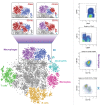Guardians of the Gut - Murine Intestinal Macrophages and Dendritic Cells
- PMID: 26082775
- PMCID: PMC4451680
- DOI: 10.3389/fimmu.2015.00254
Guardians of the Gut - Murine Intestinal Macrophages and Dendritic Cells
Abstract
Intestinal mononuclear phagocytes find themselves in a unique environment, most prominently characterized by its constant exposure to commensal microbiota and food antigens. This anatomic setting has resulted in a number of specializations of the intestinal mononuclear phagocyte compartment that collectively contribute the unique steady state immune landscape of the healthy gut, including homeostatic innate lymphoid cells, B, and T cell compartments. As in other organs, macrophages and dendritic cells (DCs) orchestrate in addition the immune defense against pathogens, both in lymph nodes and mucosa-associated lymphoid tissue. Here, we will discuss origins and functions of intestinal DCs and macrophages and their respective subsets, focusing largely on the mouse and cells residing in the lamina propria.
Keywords: IBD; dendritic cells; gut; homeostasis; inflammation; macrophages.
Figures

References
Publication types
Grants and funding
LinkOut - more resources
Full Text Sources
Other Literature Sources
Research Materials

